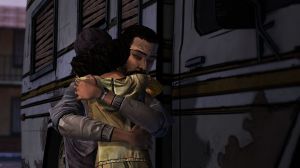Dear reader, I’m tired. A couple of months ago, I read a couple of articles, both academic and journalistic, that talked about the “death of adventure games”, more than 20 years since it supposedly happened. I expressed my frustration on Twitter, and the popularity of the post reminds me that I’m not alone in my frustration. Here’s the long version of why the phrase “death of adventure games” pushes my buttons.
Adventure games are a genre very dear to my heart – I wrote my dissertation on them, and I learned the ropes of game development making them. I had never heard of the “death of adventure games” until I came to study in the US, because in Europe adventure games kept being made and played by audiences well after the 1990s. Why do people mean when they say they died?
Most people refer to Erik Wolpaws’ article, which eviscerated one particular puzzle in Gabriel Knight 3, and identified it as the death toll of the genre. I’d say the article is a symptom of what happened in the North American industry, as well as the tendency that journalism and certain fans have to oversimplify game history.
What happened back then is that two of the largest companies making adventure games, Sierra On-Line and Lucasarts stopped developing them at the end of the 90s while continuing working on other genres. Why did they close down their adventure game divisions? We can probably guess some of the reasons, but my theory is that they probably have to do with mounting development costs, derived from projects that aspired to be interactive movies either using FMV or 3D spaces, as well as the market becoming larger and opening up to wider audiences. More importantly – and here’s a key difference between North America and Europe – game consoles were taking up a larger part of the US market, and the point-and-click interface was quite burdensome to control with console controllers, which limited the market to PC desktop machines. While the PC market remained relatively strong in Europe during the 2000s, it does not seem it was the case in North America. The profit margins were getting narrower, and investors will always take their money to whatever will give them the largest return of investment. There are probably other reasons, which may have to do with how good or bad the games were, for example, but my hunch is that it’s always money.
The adventure games of Sierra OnLine and LucasArts have been tremendously influential in the design and storytelling of games for the last two decades, including adventure games that were still being released after the supposed demise of the genre. Adventure games were not AAA blockbusters any more, they missed the “mainstream” train that would have allowed them to maintain ballooning development and publicity costs and reach larger audiences. On the other hand, they kept being developed by smaller teams, which in certain cases has allowed them a creative freedom that has kept adventure games fresh, as well as given way to a myriad subgenres, and reached smaller and underserved markets of players.
The “death of adventure games” is part of a narrative created by journalists, fans and even some developers, who revel in self-pity or want to feel special instead of celebrating the variety of games that have been appearing in the last 20 years.
Genres keep dying and reviving constantly, as Víctor Navarro-Remesal mentions – once everyone had had their share of playing with plastic guitars, music games were apparently done for. Never mind that series like Dance Dance Revolution has just turned 20, or Beat Saber (2019) was one of the runaway hits on VR headsets, and Just Dance just announced its next title. Music games had their moment where they millions of living rooms and tech offices, but although they are not as visible and omnipresent they have not gone away either, particularly outside the US. In contrast, there is no such discourse around flight simulators, which had a similar trajectory as adventure games – a relatively popular genre that did well in home computers, but which requires streamlined controls to play well in consoles. LucasArts, which was also famed for their fantastic flight simulators designed by Lawrence Holland, stopped making flight simulators a few years after closing off on adventure games. In comparison, the volume of flight simulators released in the last couple of decades has been much lower than that of adventure games, and yet the genre is celebrated with the release of certain titles, such as the latest Microsoft Flight Simulator or Star Wars: Squadrons.
And while flight simulators may have experienced a modest revival, there is hardly any acknowledgement that adventure games still remain a popular genre, even if they do not rack up the millions of AAA games. In comparison with flight simulators, we have a long list of games developed during the supposed “death” of adventure games: The Longest Journey (1999), and its sequel Dreamfall (2006), Syberia (2002), a couple of dozen titles in the Nancy Drew game series, and half of the games in the Blackwell series. These games, released during the first decade of our century, are key referents of the genre. But perhaps having women as protagonists, all of them investigators of one kind or another, independent and adventurous, may not have been in agreement with certain parts of the videogames discourse. They were plenty other titles released during that period: the Runaway series (2003-2009), as well as a good bunch of Frogwares’ Sherlock Holmes titles; both Quantic Dreams and Telltale Games rose to fame in those years. Mind how many of the titles listed are game series, which fostered enough interest to allow developers to release multiple titles and having loyal groups of players in spite of being titles of varying quality.
During this period, many people who started as “hobbyists” in the interactive fiction and adventure game communities have become comercial game developers of some of the most interesting narrative games released in the last 15 years: Emily Short (Failbetter Games), Jon Ingold (Inkle Studios), Sam Barlow (Half Mermaid) , Dave Gilbert (Wadjet Eye Games), and Francisco Gonzalez (Grundislav Games), to name but a few.
The influence of adventure games is also more than obvious in escape the room games. Originally, they were web games that took the lock-and-key mechanics of adventure games and turned them into their core gameplay. The became their own digital game form, to then inspire the thousands of escape the room spaces that are available all over the world.
The consequences of the US-centric, money-centric discourse on adventure games, which also extends to other genres, is that smaller game communities tend to be overlooked, as well as left out of funding resources because they’re not perceived as popular blockbusters. I already complained about how mid-budget games are becoming rare – when a narrative game makes a lot of money, investors considered an exception; if a narrative game by a “proven” team doesn’t make back its money in a month (even if it recoup costs in a few months), it’s supposed to be the norm. This bias derives from the way journalists, fans, developers as well academics talk about the games, not based on analyzing data, looking at the history, or finding the communities that love playing and making these games.

 ps is a relatively new thing for me. I see coffee shops as social spaces, where I meet people and have some tea and maybe a snack. (I’m not quite a coffee person.) But since my schedule has got impossibly busy over the years, I’ve learned to find a nook to work on focused tasks helps be more efficient and a bit less stressed.
ps is a relatively new thing for me. I see coffee shops as social spaces, where I meet people and have some tea and maybe a snack. (I’m not quite a coffee person.) But since my schedule has got impossibly busy over the years, I’ve learned to find a nook to work on focused tasks helps be more efficient and a bit less stressed.



